Language is one of the critical components pertaining to the identity of a nation; and learning another language can help enrich the experience of someone who is visiting a country — but teaching yourself to speak a foreign language can introduce you to the culture of another land while simultaneously broadening your horizons.
I have been given express written permission to use the maps and the verbatim text from this article written for WordTips, which highlights what are purported to be the most popular languages people in each country around the world wanted to learn. While WordTips has endeavored to ensure the information provided is accurate and current, it cannot guarantee it. Neither WordTips nor The Gate accept liability for the information which is presented in this article.
Which Language Did People Want to Learn Most in Each Country During the 2019 Novel Coronavirus Pandemic?
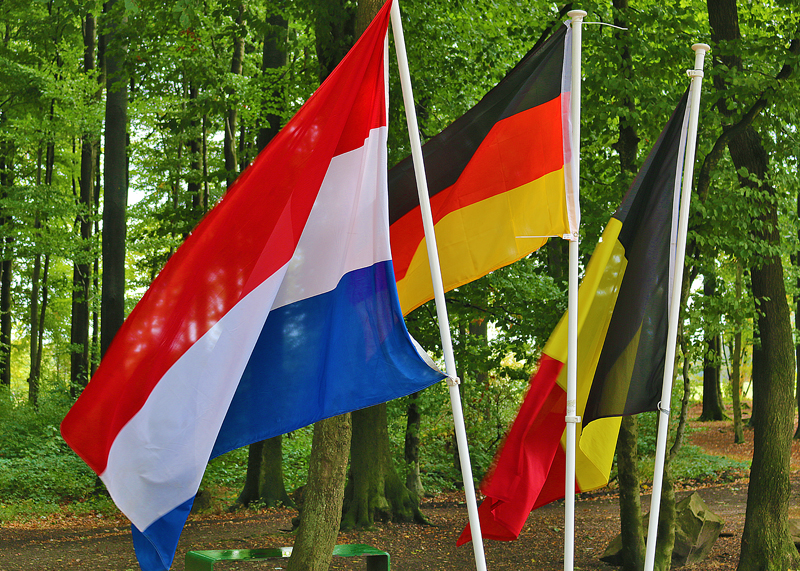
Uno? Deux? 셋? How many languages did you learn during lockdown?
The first year of the pandemic was an annus horribilis for language teachers. Schools closed, foreign exchange trips were canceled, language meet-ups shut down.
To add insult to injury, a cartel of national academies declared that language learning was already kaput (among English speakers, at least). “To work together, the people of the world must be able to speak to each other and be understood,” they lamented.
But something odd happened. Language learning boomed. Armed with a language-learning app and their favorite foreign-language Netflix show, the furloughed of the world became autodidacts.
Teaching yourself to speak a foreign language while airports were closed may seem loco. But learning a new language gives a taste of another culture, keeps your brain active and healthy, and helps you think and see in new ways. Plus, of course, you may have been dreaming of your first post-lockdown vacation. Google searches for ‘2021 holiday’ spiked by 124% in April 2020, even as Duolingo subscriptions leaped by 300%.
Methodology
WordTips was curious which nationalities were choosing which languages during lockdown. We used Google’s Keyword Planner to find the number of searches for ‘learn x language’ (translated into different languages) in every country from May 2020 to May 2021. And we mapped the most popular language to learn around the world.
We compiled a list of the top 50 most spoken languages based on our previous article ‘The 100 Most-Spoken Languages in the World.’
Then we translated the following phrases into 119 languages:
- [Language Name] language (e.g. “English language”);
- Study [Language Name] (e.g. “Study English”);
- Learn [Language Name] (e.g. “Learn English”)
Then we used Ahrefs to identify monthly Google search volumes of those phrases translated to one of the official or widely used languages of the country. Then we summed up the monthly search volumes of the phrases and found out the two most popular languages in every country.
Finally, we enriched our data with the number of internet users and calculated the number of yearly searches per 1000 internet users.
The data was collected in May 2021.
Key Findings:
- English is the most popular language to learn in 98 countries.
- Japanese is very popular in the English-speaking world — it’s the most popular language to learn in Canada, USA, Australia, and New Zealand.
- Ukraine is the country with highest interest in the local language, with 25.94 yearly searches per 1,000 internet users for Ukrainian.
- Arabic is the most popular language to learn in 12 countries — Bahrain, Egypt, Jordan, Kuwait, Lebanon, Maldives, Niger, Oman, Palestine, Qatar, Saudi Arabia, and the United Arab Emirates.
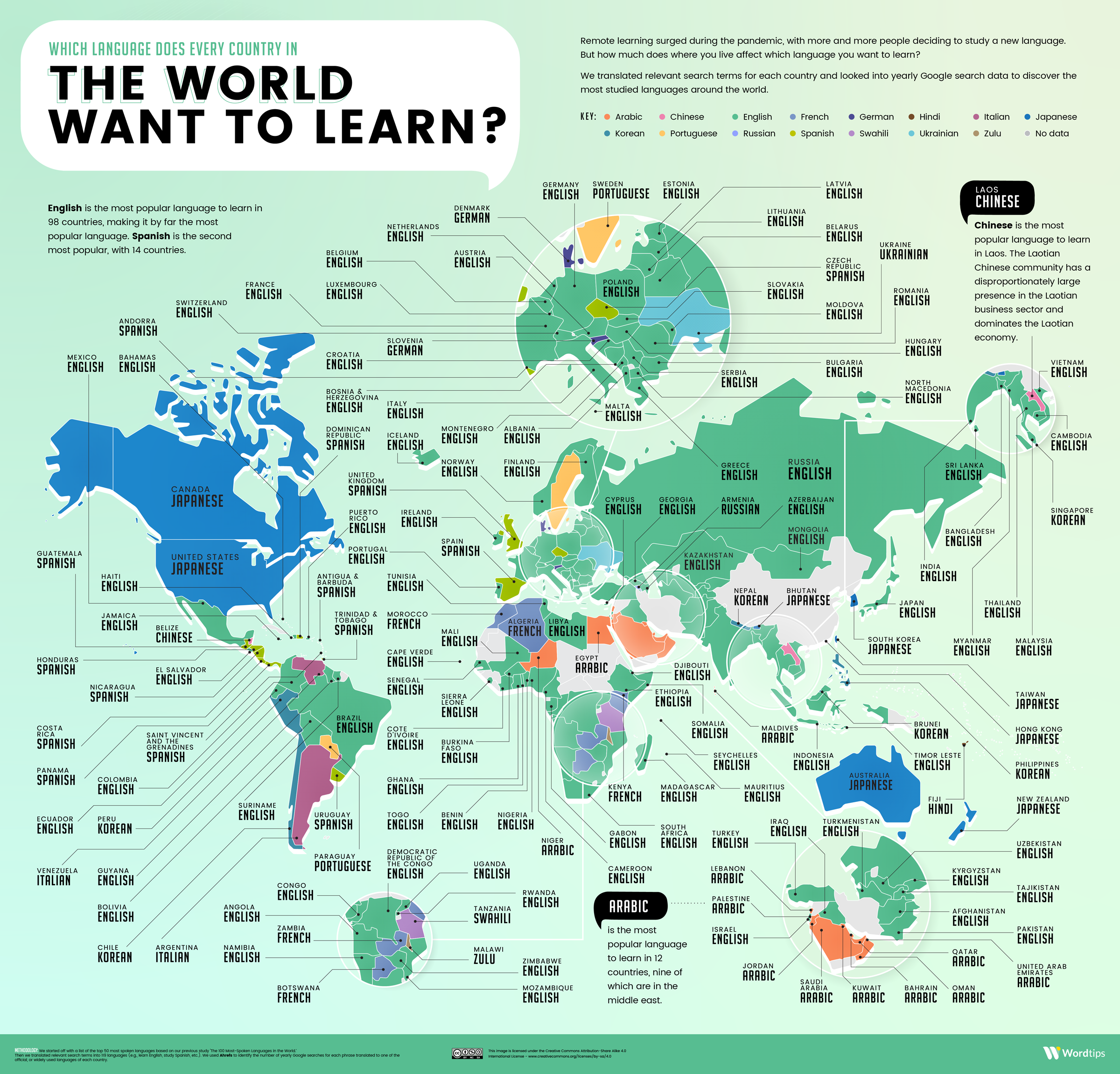
North America
Spanish and English learners dominate North America. People in half of these territories are most likely to search for Spanish lessons online. It may seem strange that Spanish-speaking North American countries have high search rates, but consider the example of Guatemala: Spanish is the official language, but more than a million Guatemalans speak one of 24 local indigenous languages.

The top language in the US and Canada may also be a surprise. Japanese is booming thanks to Japan’s rich export culture of anime and manga. Today’s adults grew up on it, so they already have a taste for Japanese arts. Their kids are bingeing it right now and getting curious about a trip to Asia. China’s economy may loom heavier than Japan’s, but both make good bets for employability prospects – and many still see Japan as a safer destination.
South America
In six of the 12 sovereign states of South America, the top language to learn at home is English. But in Argentina, Italian dominates. Nearly two-thirds of Argentines have Italian ancestry, and many know themselves as ‘tanos’ – local Lunfardo slang for ‘Italians.’ Argentina’s brand of Spanish is called Castellano for its roots in Castilla, Spain, but it has developed an Italian sound over the years.
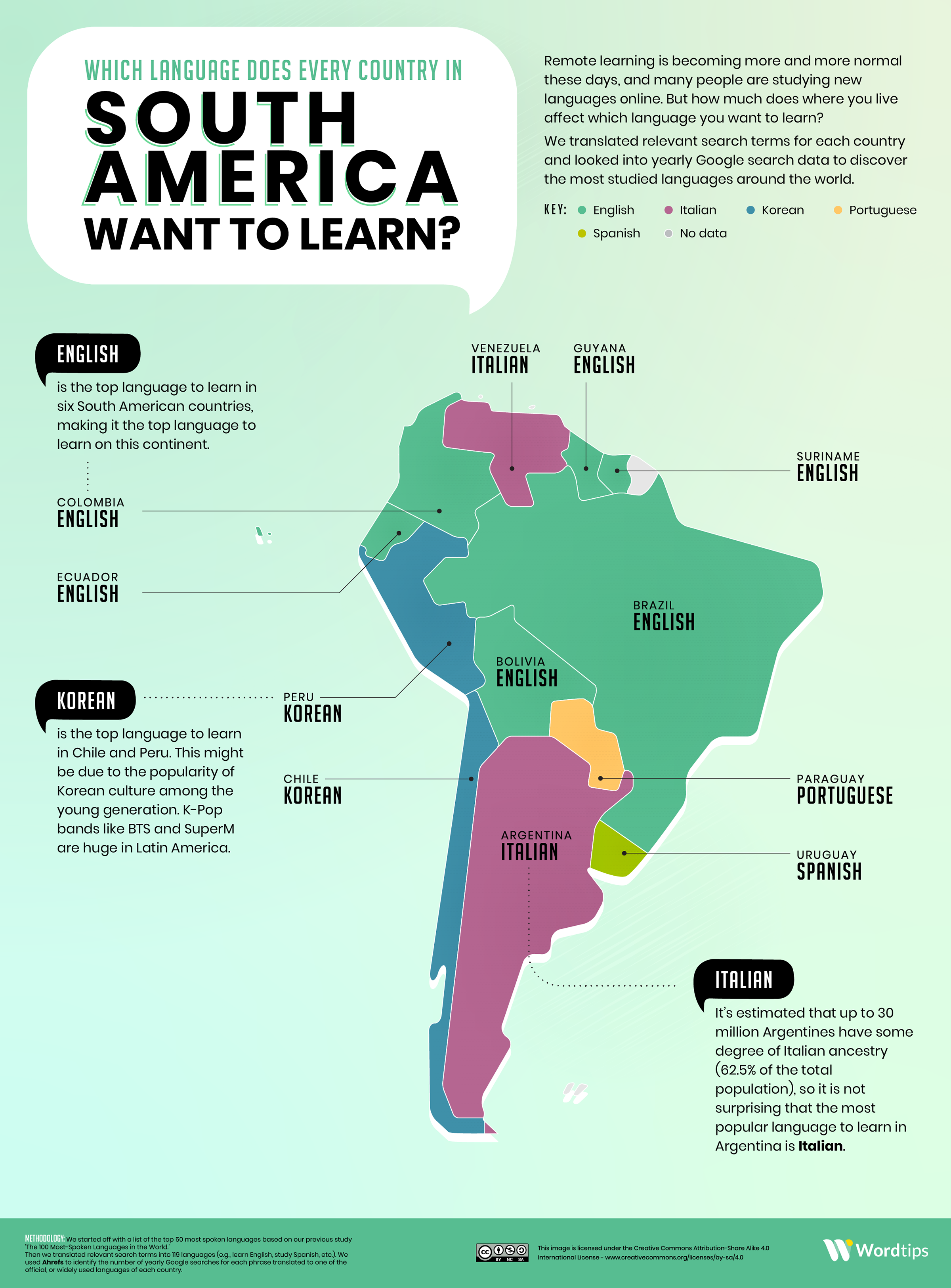
More than one in a thousand Peruvian internet users searched for Korean lessons last year, and Korean was also the top language to learn in Chile. Despite being far away and having superficially different cultures, Korean pop music has become big in Latin America. The K-Pop genre has underlying similarities to Latin music but offers a fresh, more innocent take on popular themes.
Europe
The search for language study is more intense to the east of Europe than in the west. Ukraine has the highest search rate in the world for its native language. The majority of Ukrainians speak it as their first language, but Russian was the dominant language in the Soviet era and is still most common in some areas. Russian-speaking Ukrainians may feel the urge to learn the language as tensions with Russia continue – particularly since language has become a hot cultural issue in Ukraine.
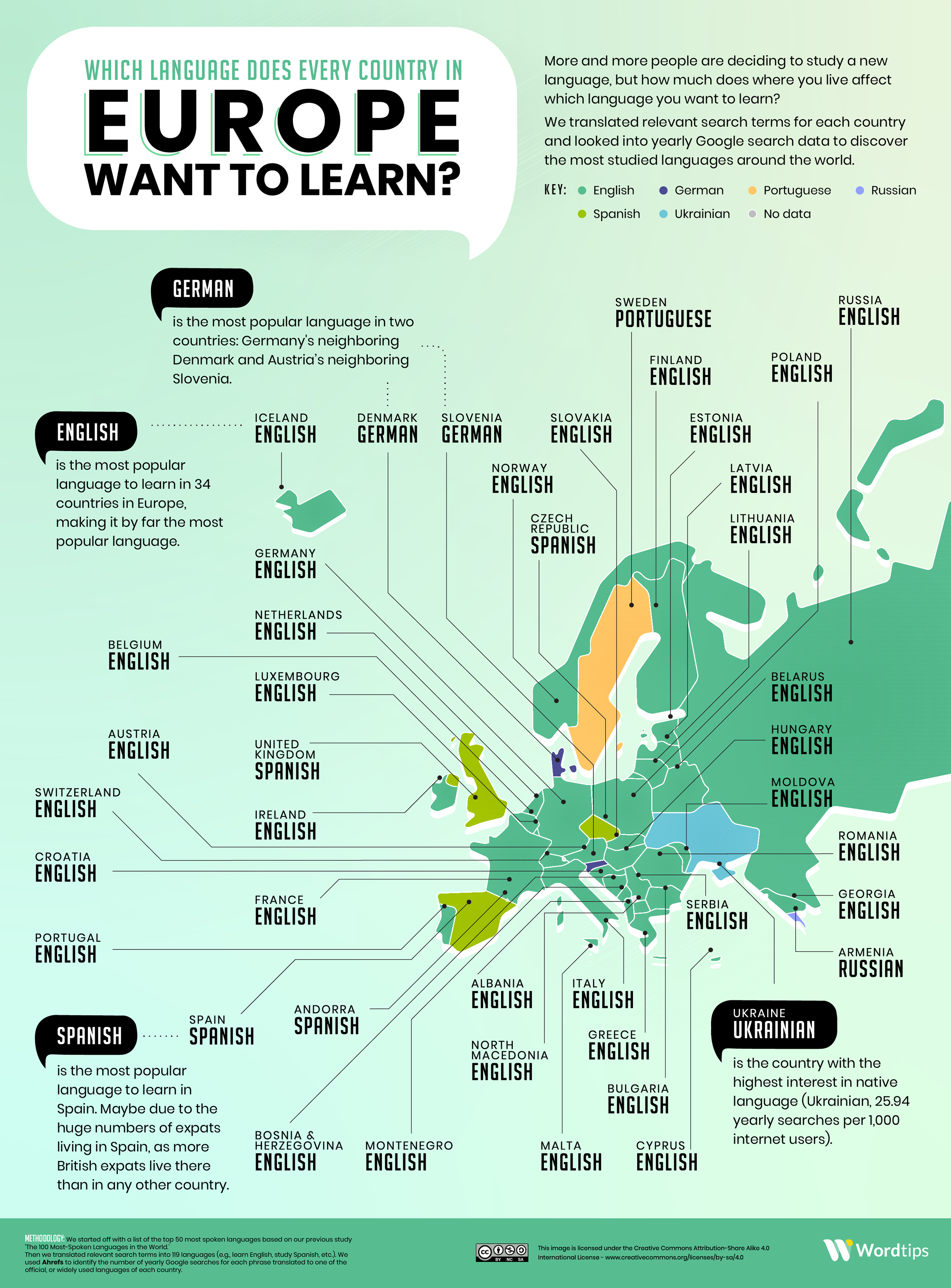
Russia also has a high search rate for language learning, although the most popular choice is English. Western Europeans tend to study English or Spanish. However, Portuguese is the first-choice language to learn in Sweden. Portugal is a popular holiday home and retirement destination for swathes of wealthy Scandinavians desperately seeking winter sunlight.
Middle East & Central Asia
This region is equally divided between English and Arabic learners. Arabic is the official language of all of the countries where it is the most studied in this region. However, there are large expatriate communities and minority cultures in many Arabic countries, as well as regional variations on the language that may lead locals to study Arabic.
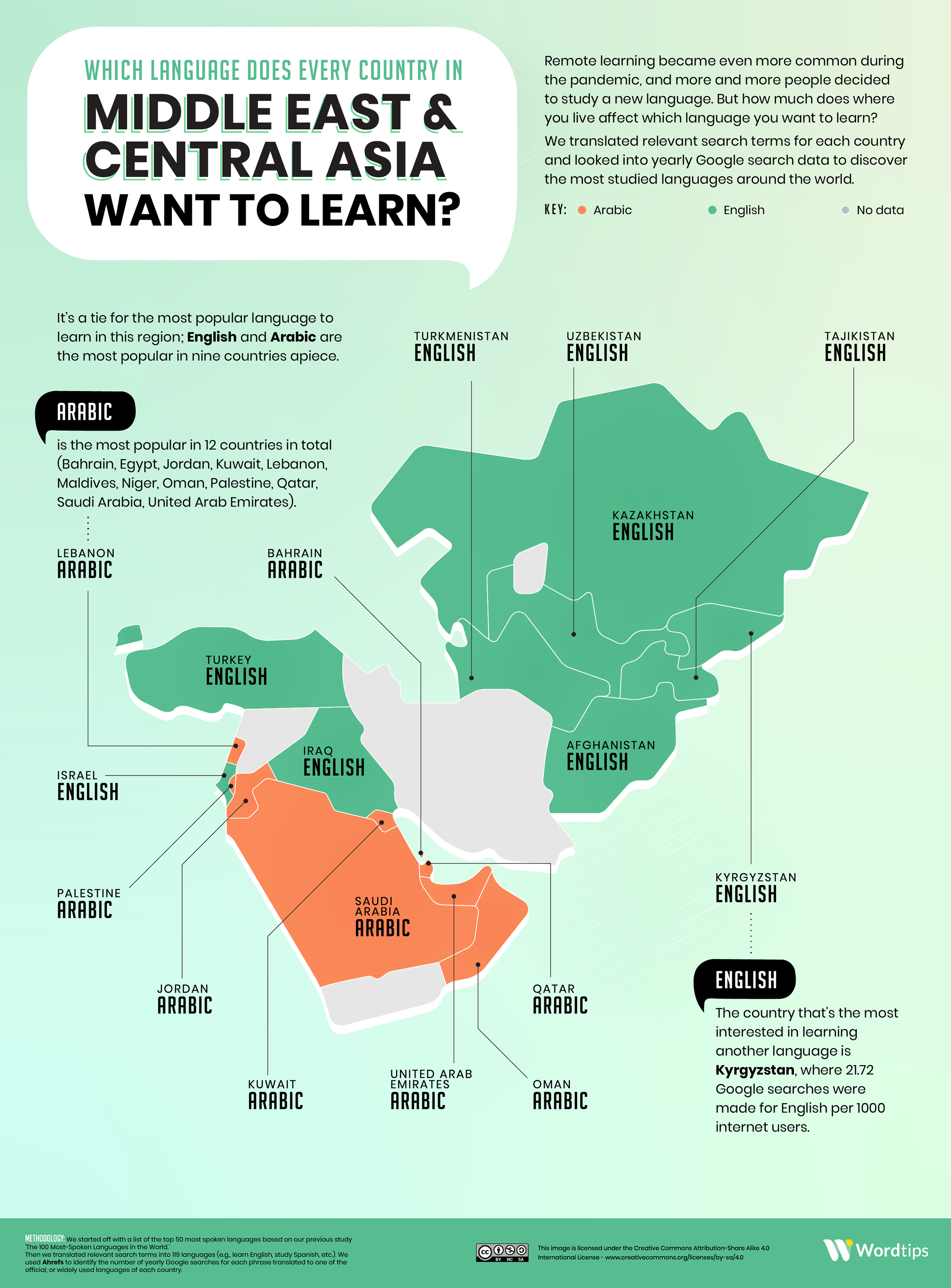
English may be the lingua franca of the business world, but English language proficiency is relatively low in Arab societies. However, the English language is an asset to unemployed Middle Eastern people whether they intend to emigrate for work or apply locally. One study found that employees with strong English language skills earn up to 200% more in Iraq than those without.
Rest of Asia & Oceania
The Hindi language makes its only appearance in our study for this region. The British forcibly relocated over 60,000 Indian people to Fiji in the form of legitimized slavery between 1879 and 1916. By the end of WWII, Indo- Fijians were the majority population on the islands, although today they are in the minority. Most Indo-Fijians speak Fiji Hindi, but there is a minor fundamentalist movement to replace it with standard Hindi in some settings.
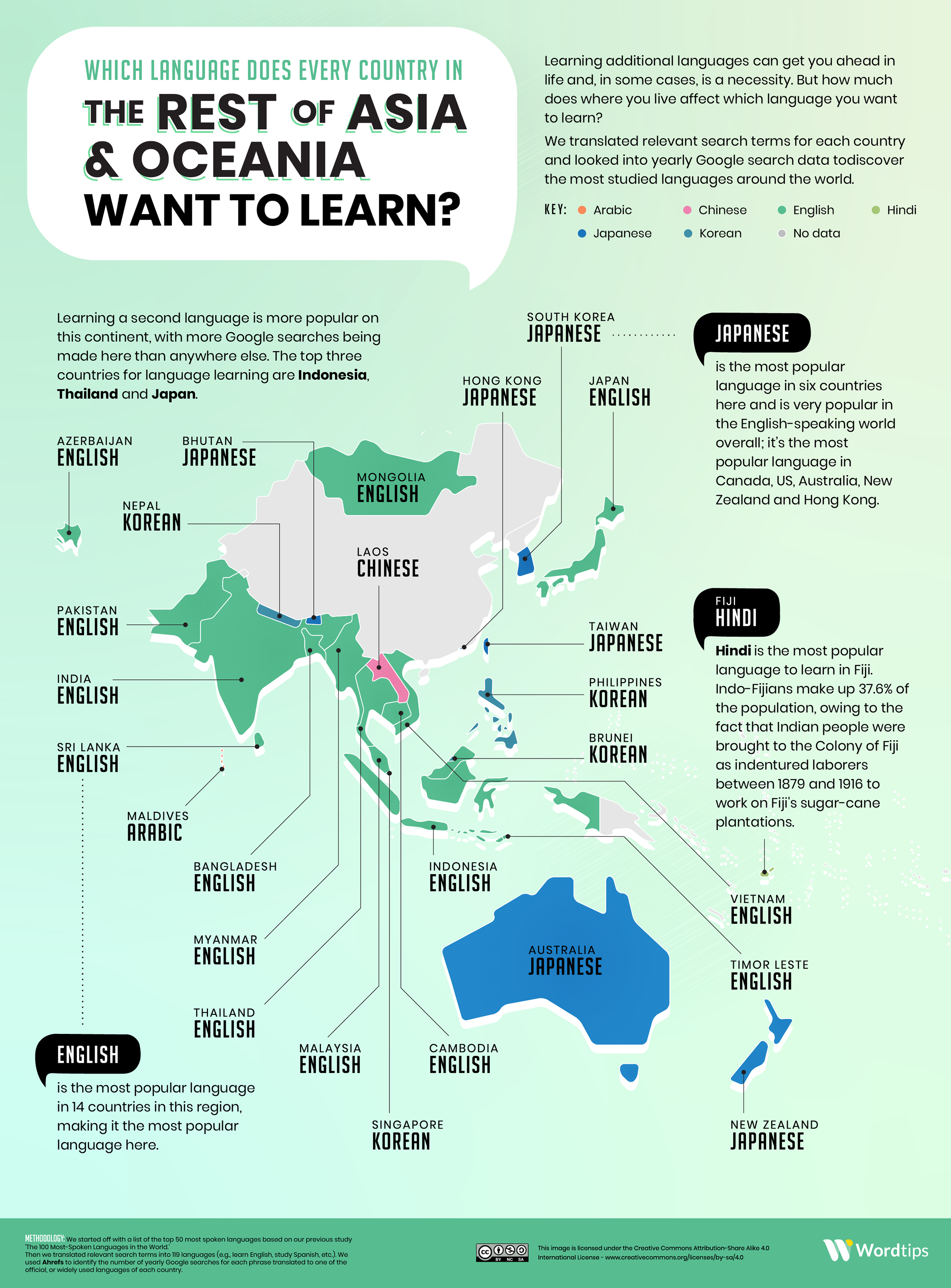
Japanese is the most sought-after language to learn in Australia and New Zealand. The Asian country is a neighbor of these countries, and they maintain strong cultural and economic ties, with significant immigration between them. Australian schools commonly teach Japanese, promoting cooperation and employment opportunities in business, diplomacy, and tourism.
Africa
Africa is the only continent with countries that want to learn French more than any other language. The African countries searching for French lessons include a former French colony (Algeria) and protectorate (Morocco) as well as Botswana, Kenya, and Zambia.
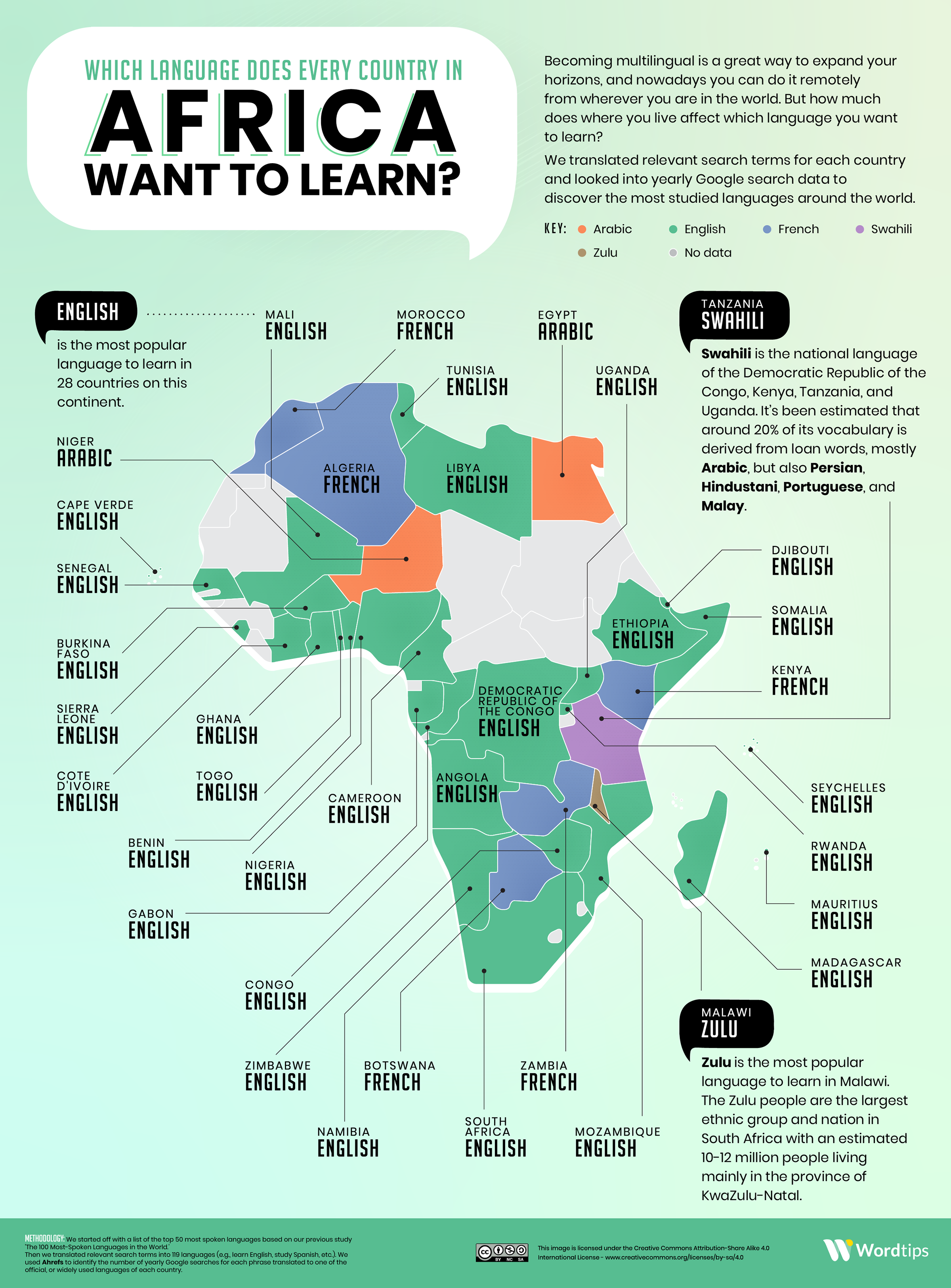
Egyptians mostly speak one of the various unofficial Arabic dialects. However, there are differences between Egyptian Arabic and the ‘literary’ or Modern Standard Arabic, which is used in most written media and for international business. Internet users searching for Arabic lessons in Egypt may be locals looking for more formal education or immigrants learning the native or official tongue.
The Second Most-Searched Language Classes In Every Country
Of course, it shouldn’t be assumed that the most-searched language to learn in each country is representative of the whole nation. Open it up to the second most popular language search, and the picture broadens. For example, French only appears in Africa as a most popular search but is also sought-after in Canada, Portugal, and Bosnia, among other places, as an alternative language to learn.
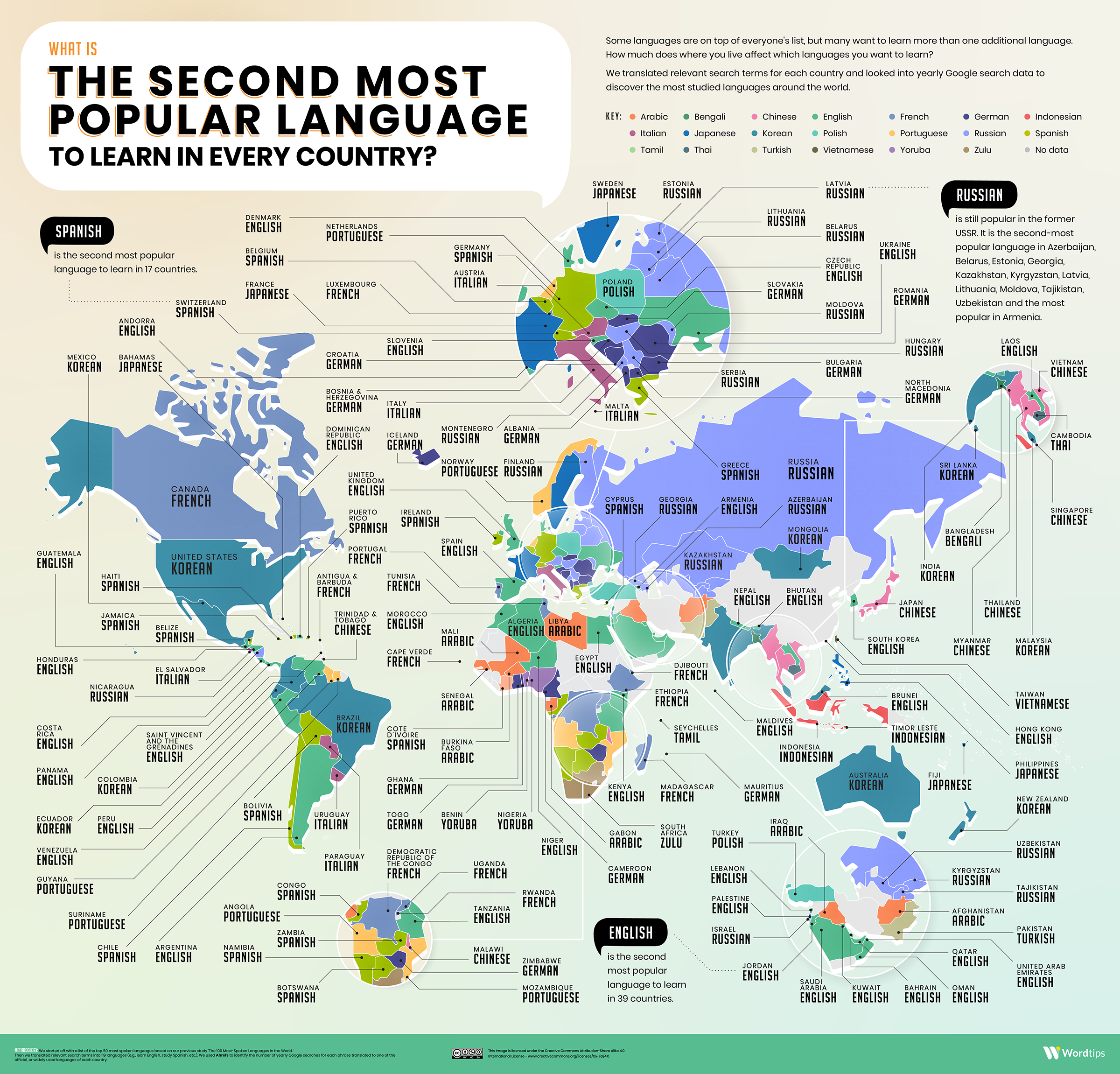
This map also reveals the popularity of Polish, Indonesian, Tamil, Thai, Turkish, and Vietnamese, none of which appeared in the first set of maps. The Taiwanese government is campaigning to encourage immigrants to teach their native (heritage) languages to their children. There are over 80,000 children with dual Vietnamese-Taiwanese citizenship in Taiwan, and schools have taught Vietnamese since 2018.
Language is a powerful tool to mend much of what has broken through the coronavirus pandemic. Learning a new language can aid communication, understanding, and cooperation; it can boost cognition, make you more employable, and improve the business outlook all around.
Plus, languages are fun, fascinating, and a gateway to new cultures. Just think of all those foreign language Scrabble tournaments you’ll be able to win!
Summary
Language has always been somewhat of a cursory interest to me; and I attempt to speak at least one word of it in every country which I visit. That one word is actually two words in English: thank you. I am amazed at how many times people appreciate that I attempt to speak in their native language — even if it is only one word.
Which language would you like to learn as your second language?
Other articles at The Gate which pertain to language include:
- Saying Thank You in Lithuanian is Nothing to Sneeze At
- Do You Speak Germxn? Do We Really Need Gender Neutral Names of Languages?
- They Don’t Realize That You DO Know What They’re Saying: Languages
- Language Translation Has Improved With This Updated Software From Google…
- What Are the Third-Most Popular Languages in Every Country in the World?
- Stupid Tip of the Day: Do Not Speak a Different Language TOO Well…
- Language: Why Do We Name Places As We Do?
- Language Translation is Even Easier With This Updated Software From Google…
- Stupid Tip of the Day: Learning Another Language When You Have No Time
All photographs ©2018 by Brian Cohen.

